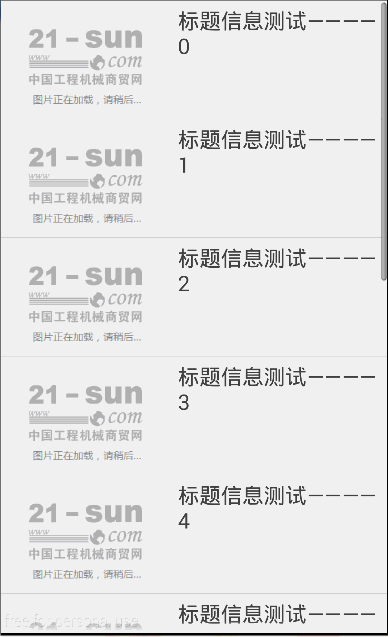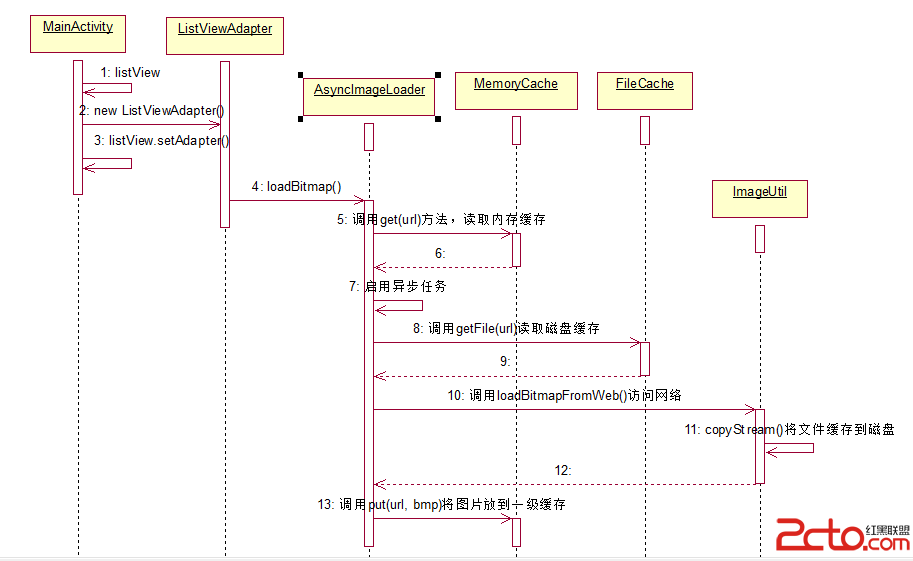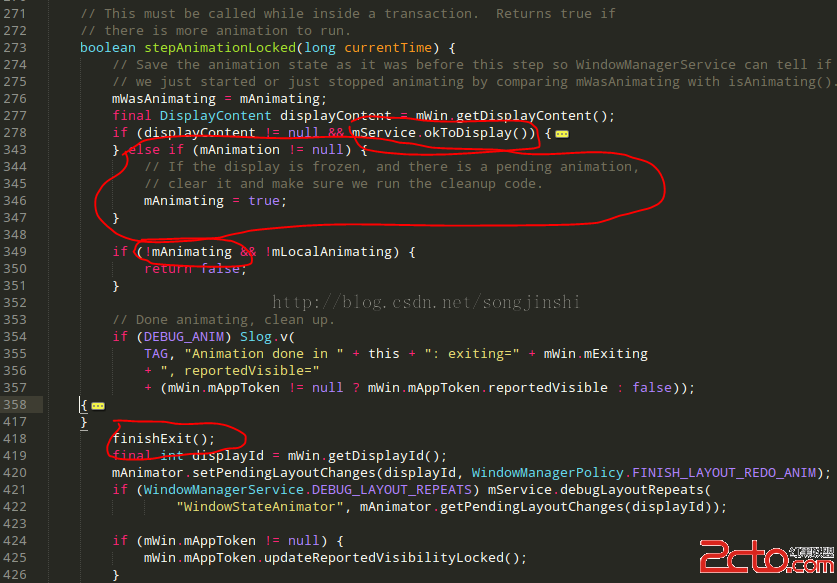編輯:關於Android編程
Android應用中經常涉及從網絡中加載大量圖片,為提升加載速度和效率,減少網絡流量都會采用二級緩存和異步加載機制,所謂二級緩存就是通過先從內存中獲取、再從文件中獲取,最後才會訪問網絡。內存緩存(一級)本質上是Map集合以key-value對的方式存儲圖片的url和Bitmap信息,由於內存緩存會造成堆內存洩露, 管理相對復雜一些,可采用第三方組件,對於有經驗的可自己編寫組件,而文件緩存比較簡單通常自己封裝一下即可。下面就通過案例看如何實現網絡圖片加載的優化。
二、案例介紹案例新聞的列表圖片

下面先看看實現一級緩存(內存)、二級緩存(磁盤文件)所編寫的組件
在內存中存儲圖片(一級緩存), 采用了1個map來緩存圖片代碼如下:
public class MemoryCache { // 最大的緩存數 private static final int MAX_CACHE_CAPACITY = 30; //用Map軟引用的Bitmap對象, 保證內存空間足夠情況下不會被垃圾回收 private HashMap> mCacheMap = new LinkedHashMap>() { private static final long serialVersionUID = 1L; //當緩存數量超過規定大小(返回true)會清除最早放入緩存的 protected boolean removeEldestEntry( Map.Entry> eldest){ return size() > MAX_CACHE_CAPACITY;}; }; /** * 從緩存裡取出圖片 * @param id * @return 如果緩存有,並且該圖片沒被釋放,則返回該圖片,否則返回null */ public Bitmap get(String id){ if(!mCacheMap.containsKey(id)) return null; SoftReference ref = mCacheMap.get(id); return ref.get(); } /** * 將圖片加入緩存 * @param id * @param bitmap */ public void put(String id, Bitmap bitmap){ mCacheMap.put(id, new SoftReference(bitmap)); } /** * 清除所有緩存 */ public void clear() { try { for(Map.Entry>entry :mCacheMap.entrySet()) { SoftReference sr = entry.getValue(); if(null != sr) { Bitmap bmp = sr.get(); if(null != bmp) bmp.recycle(); } } mCacheMap.clear(); } catch (Exception e) { e.printStackTrace();} } }
在磁盤中緩存圖片(二級緩存),代碼如下
public class FileCache { //緩存文件目錄 private File mCacheDir; /** * 創建緩存文件目錄,如果有SD卡,則使用SD,如果沒有則使用系統自帶緩存目錄 * @param context * @param cacheDir 圖片緩存的一級目錄 */ public FileCache(Context context, File cacheDir, String dir){ if(android.os.Environment.getExternalStorageState().equals、(android.os.Environment.MEDIA_MOUNTED)) mCacheDir = new File(cacheDir, dir); else mCacheDir = context.getCacheDir();// 如何獲取系統內置的緩存存儲路徑 if(!mCacheDir.exists()) mCacheDir.mkdirs(); } public File getFile(String url){ File f=null; try { //對url進行編輯,解決中文路徑問題 String filename = URLEncoder.encode(url,"utf-8"); f = new File(mCacheDir, filename); } catch (UnsupportedEncodingException e) { e.printStackTrace(); } return f; } public void clear(){//清除緩存文件 File[] files = mCacheDir.listFiles(); for(File f:files)f.delete(); } }
android中采用單線程模型即應用運行在UI主線程中,且Android又是實時操作系統要求及時響應否則出現ANR錯誤,因此對於耗時操作要求不能阻塞UI主線程,需要開啟一個線程處理(如本應用中的圖片加載)並將線程放入隊列中,當運行完成後再通知UI主線程進行更改,同時移除任務——這就是異步任務,在android中實現異步可通過本系列一中所用到的AsyncTask或者使用thread+handler機制,在這裡是完全是通過代碼編寫實現的,這樣我們可以更清晰的看到異步通信的實現的本質,代碼如下
public class AsyncImageLoader{ private MemoryCache mMemoryCache;//內存緩存 private FileCache mFileCache;//文件緩存 private ExecutorService mExecutorService;//線程池 //記錄已經加載圖片的ImageView private Map mImageViews = Collections .synchronizedMap(new WeakHashMap()); //保存正在加載圖片的url private List mTaskQueue = new ArrayList(); /** * 默認采用一個大小為5的線程池 * @param context * @param memoryCache 所采用的高速緩存 * @param fileCache 所采用的文件緩存 */ public AsyncImageLoader(Context context, MemoryCache memoryCache, FileCache fileCache) { mMemoryCache = memoryCache; mFileCache = fileCache; mExecutorService = Executors.newFixedThreadPool(5);//建立一個容量為5的固定尺寸的線程池(最大正在運行的線程數量) } /** * 根據url加載相應的圖片 * @param url * @return 先從一級緩存中取圖片有則直接返回,如果沒有則異步從文件(二級緩存)中取,如果沒有再從網絡端獲取 */ public Bitmap loadBitmap(ImageView imageView, String url) { //先將ImageView記錄到Map中,表示該ui已經執行過圖片加載了 mImageViews.put(imageView, url); Bitmap bitmap = mMemoryCache.get(url);//先從一級緩存中獲取圖片 if(bitmap == null) { enquequeLoadPhoto(url, imageView);//再從二級緩存和網絡中獲取 } return bitmap; } /** * 加入圖片下載隊列 * @param url */ private void enquequeLoadPhoto(String url, ImageView imageView) { //如果任務已經存在,則不重新添加 if(isTaskExisted(url)) return; LoadPhotoTask task = new LoadPhotoTask(url, imageView); synchronized (mTaskQueue) { mTaskQueue.add(task);//將任務添加到隊列中 } mExecutorService.execute(task);//向線程池中提交任務,如果沒有達到上限(5),則運行否則被阻塞 } /** * 判斷下載隊列中是否已經存在該任務 * @param url * @return */ private boolean isTaskExisted(String url) { if(url == null) return false; synchronized (mTaskQueue) { int size = mTaskQueue.size(); for(int i=0; i
編寫完成之後,對於異步任務的執行只需調用AsyncImageLoader中的loadBitmap()方法即可非常方便,對於AsyncImageLoader組件的代碼最好結合注釋好好理解一下,這樣對於Android中線程之間的異步通信就會有深刻的認識。
public class ImageUtil { /** * 從網絡獲取圖片,並緩存在指定的文件中 * @param url 圖片url * @param file 緩存文件 * @return */ public static Bitmap loadBitmapFromWeb(String url, File file) { HttpURLConnection conn = null; InputStream is = null; OutputStream os = null; try { Bitmap bitmap = null; URL imageUrl = new URL(url); conn = (HttpURLConnection) imageUrl.openConnection(); conn.setConnectTimeout(30000); conn.setReadTimeout(30000); conn.setInstanceFollowRedirects(true); is = conn.getInputStream(); os = new FileOutputStream(file); copyStream(is, os);//將圖片緩存到磁盤中 bitmap = decodeFile(file); return bitmap; } catch (Exception ex) { ex.printStackTrace(); return null; } finally { try { if(os != null) os.close(); if(is != null) is.close(); if(conn != null) conn.disconnect(); } catch (IOException e) { } } } public static Bitmap decodeFile(File f) { try { return BitmapFactory.decodeStream(new FileInputStream(f), null, null); } catch (Exception e) { } return null; } private static void copyStream(InputStream is, OutputStream os) { final int buffer_size = 1024; try { byte[] bytes = new byte[buffer_size]; for (;;) { int count = is.read(bytes, 0, buffer_size); if (count == -1) break; os.write(bytes, 0, count); } } catch (Exception ex) { ex.printStackTrace(); } } }
四、測試應用
組件之間的時序圖:

public class MainActivity extends Activity { ListView list; ListViewAdapter adapter; @Override public void onCreate(Bundle savedInstanceState) { super.onCreate(savedInstanceState); setContentView(R.layout.main); list=(ListView)findViewById(R.id.list); adapter=new ListViewAdapter(this, mStrings); list.setAdapter(adapter); } public void onDestroy(){ list.setAdapter(null); super.onDestroy(); adapter.destroy(); } private String[] mStrings={ "http://news.21-sun.com/UserFiles/x_Image/x_20150606083511_0.jpg", "http://news.21-sun.com/UserFiles/x_Image/x_20150606082847_0.jpg", …..}; }
public class ListViewAdapter extends BaseAdapter { private Activity mActivity; private String[] data; private static LayoutInflater inflater=null; private AsyncImageLoader imageLoader;//異步組件 public ListViewAdapter(Activity mActivity, String[] d) { this.mActivity=mActivity; data=d; inflater = (LayoutInflater)mActivity.getSystemService( Context.LAYOUT_INFLATER_SERVICE); MemoryCache mcache=new MemoryCache();//內存緩存 File sdCard = android.os.Environment.getExternalStorageDirectory();//獲得SD卡 File cacheDir = new File(sdCard, "jereh_cache" );//緩存根目錄 FileCache fcache=new FileCache(mActivity, cacheDir, "news_img");//文件緩存 imageLoader = new AsyncImageLoader(mActivity, mcache,fcache); } public int getCount() { return data.length; } public Object getItem(int position) { return position; } public long getItemId(int position) { return position; } public View getView(int position, View convertView, ViewGroup parent) { ViewHolder vh=null; if(convertView==null){ convertView = inflater.inflate(R.layout.item, null); vh=new ViewHolder(); vh.tvTitle=(TextView)convertView.findViewById(R.id.text); vh.ivImg=(ImageView)convertView.findViewById(R.id.image); convertView.setTag(vh); }else{ vh=(ViewHolder)convertView.getTag(); } vh.tvTitle.setText("標題信息測試———— "+position); vh.ivImg.setTag(data[position]); //異步加載圖片,先從一級緩存、再二級緩存、最後網絡獲取圖片 Bitmap bmp = imageLoader.loadBitmap(vh.ivImg, data[position]); if(bmp == null) { vh.ivImg.setImageResource(R.drawable.default_big); } else { vh.ivImg.setImageBitmap(bmp); } return convertView; } private class ViewHolder{ TextView tvTitle; ImageView ivImg; } public void destroy() { imageLoader.destroy(); } }
想要了解更多內容的小伙伴,可以點擊查看源碼,親自運行測試。
疑問咨詢或技術交流,請加入官方QQ群: (452379712)
(452379712)
作者:傑瑞教育
 Andrdoid中對應用程序的行為攔截實現方式之----從底層C進行攔截
Andrdoid中對應用程序的行為攔截實現方式之----從底層C進行攔截
之前的一篇概要文章中主要說了我這次研究的一些具體情況,這裡就不在多說了,但是這裡還需要指出的是,感謝一下三位大神願意分享的知識(在我看來,懂得分享和細致的人才算是大神,不
 android tv焦點特效實現淺析
android tv焦點特效實現淺析
Android TV上的焦點凸顯特效相信大家都看到過,那麼我們就來實現它吧,首先上張效果圖。 先說一下實現原理,主要通過重寫RelativeLayout實現item,
 [Android] SQLite數據庫之增刪改查基礎操作
[Android] SQLite數據庫之增刪改查基礎操作
在編程中經常會遇到數據庫的操作,而Android系統內置了SQLite,它是一款輕型數據庫,遵守事務ACID的關系型數據庫管理系統,它占用的資源非常低,能夠支持Windo
 AndroidManifest配置文件介紹
AndroidManifest配置文件介紹
本 質:AndroidManifest.xml 是 整 個 應 用 的 主 配 置 清 單 文 件 。 包 含 :該 應 用 的 包 名 、 版 本 號 、 組 件 、
 Android5.0L退出APP橫豎屏切換導致的觸摸屏輸入(Touch Event)無效(凍屏)問題分析(Key Event仍然有效)
Android5.0L退出APP橫豎屏切換導致的觸摸屏輸入(Touch Event)無效(凍屏)問題分析(Key Event仍然有效)
一、問題現象1、多次進出需要強制橫屏的app,比如Real FootBa